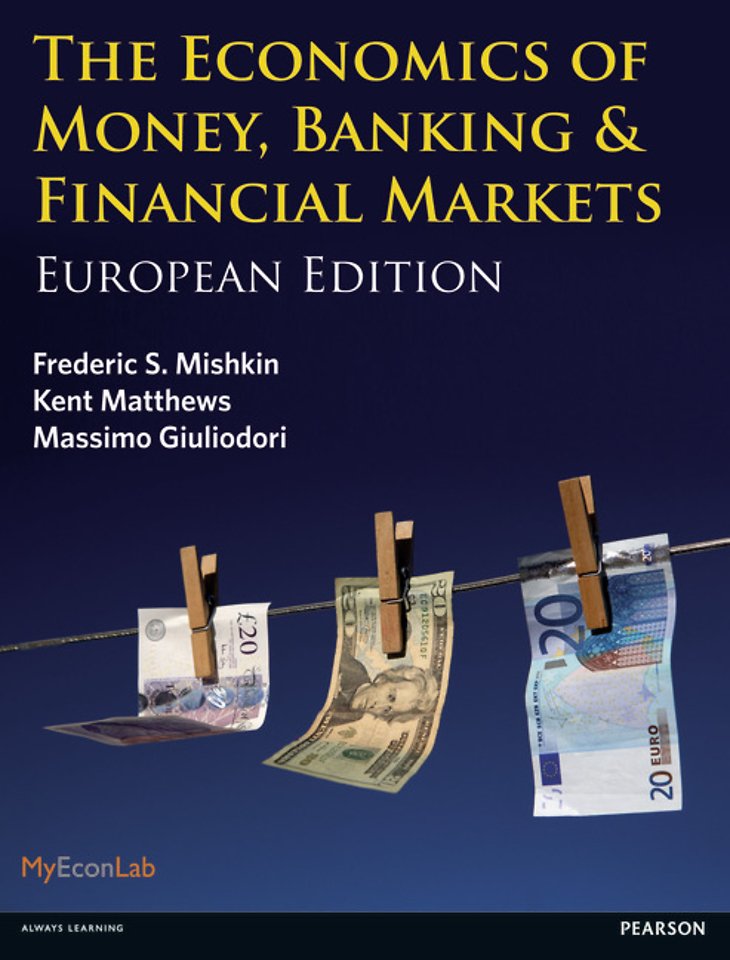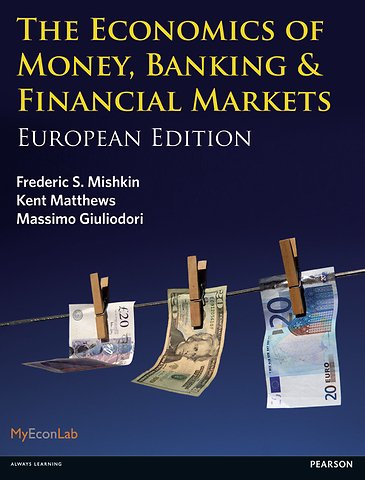Economics of Money, Banking and Financial Markets
European edition
Paperback Engels 2013 9780273731801Samenvatting
Were you looking for the book with access to MyEconLab? This product is the book alone, and does NOT come with access to MyEconLab.
This European adaptation takes Mishkin’s market leading The Economics of Money, Banking and Financial Markets a step further placing the central themes in context for European students. It provides an in-depth overview and comparison of the structures, goals, tools and strategies of the European Central Bank, the Bank of England and the US Federal Reserve.
Mishkin’s application of a unified analytical framework to the models makes theory intuitive for students whilst the rich array of current, real-world events keeps students motivated. Authoritative, comprehensive, and flexible, the text is easy to integrate into a wide variety of syllabi, and its ancillaries provide complete support when teaching the course.
Frederic Mishkinstudied at MIT and has taught at Columbia Business School since 1983. He was a member of the Board of Governors of the Federal Reserve System from 2006 to 2008 and has been a consultant to the World Bank, the Inter-American Development Bank, and the International Monetary Fund, as well as to numerous central banks throughout the world
Kent Matthewsis the Sir Julian Hodge Professor of Banking and Finance at the Cardiff Business School. He is a graduate of the London School of Economics, Birkbeck and Liverpool University and has held research posts at the LSE, National Institute of Economic & Social Research and Bank of England.
Massimo Giuliodori took his first degree at the University of Ancona (Italy) and his MSc in Economics and Finance at the University of Glasgow. After obtaining his PhD from the Scottish Doctoral Programme, he moved to the Amsterdam School of Economics of the University of Amsterdam, where he is now Associate Professor.
Specificaties
Lezersrecensies
Inhoudsopgave
Guided tour
Authors’ acknowledgements
Publisher’s acknowledgements
Introduction
Part 1 Introduction
1 Why study money, banking and financial markets?
Why study financial markets?
Why study financial institutions and banking?
Why study money and monetary policy?
Why study international finance?
How will we study money, banking and financial markets?
Web exercises
Concluding remarks
Summary
Key terms
Questions and problems
Web exercises
Notes
Web references
Appendix to Chapter 1 Defining aggregate output, income, the price level and the inflation rate
2 An overview of the financial system
Function of financial markets
Structure of financial markets
Financial market instruments
Internationalization of financial markets
Function of financial intermediaries: indirect finance
Types of financial intermediaries
Regulation of the financial system
Summary
Key terms
Questions and problems
Web exercises
Notes
Web references
3 What is money? A comparative approach to measuring money
Meaning of money
Functions of money
Evolution of the payments system
Measuring money
Which is the most accurate monetary aggregate?
Summary
Key terms
Questions and problems
Web exercises
Notes
Web references
Part 2 Financial markets
4 Understanding interest rates
Measuring interest rates
The distinction between interest rates and returns
The distinction between real and nominal interest rates
Summary
Key terms
Questions and problems
Web exercises
Notes
Web references
5 The behaviour of interest rates
Determinants of asset demand
Supply and demand in the bond market
Changes in equilibrium interest rates
Supply and demand in the market for money: the liquidity preference framework
Changes in equilibrium interest rates in the liquidity preference framework
Summary
Key terms
Questions and problems
Web exercises
Notes
Web references
6 The risk and term structure of interest rates
Risk structure of interest rates
Term structure of interest rates
Summary
Key terms
Questions and problems
Web exercises
Notes
Web references
7 The stock market, the theory of rational expectations and the efficient market hypothesis
Computing the price of common stock
How the market sets stock prices
The theory of rational expectations
The efficient market hypothesis: rational expectations in financial markets
Behavioural finance
Summary
Key terms
Questions and problems
Web exercises
Notes
Web references
Part 3 Financial institutions
8 An economic analysis of financial structure
Basic facts about financial structure throughout the world
Transaction costs
Asymmetric information: adverse selection and moral hazard
The lemons problem: how adverse selection influences financial structure
How moral hazard affects the choice between debt and equity contracts
How moral hazard influences financial structure in debt markets
Conflicts of interest
Summary
Key terms
Questions and problems
Web exercises
Notes
Web references
9 Financial crises and the subprime meltdown
Factors causing financial crises
Dynamics of past financial crises in developed countries
The subprime financial crisis of 2007–8
Dynamics of financial crises in emerging market economies
Dynamics of the eurozone financial crisis
Summary
Key terms
Questions and problems
Web exercises
Notes
Web references
10 Banking and the management of financial institutions
The bank balance sheet
Basic banking
General principles of bank management
Managing credit risk
Managing interest-rate risk
Off-balance-sheet activities
Summary
Key terms
Questions and problems
Web exercises
Notes
Web references
11 Economic analysis of financial regulation
Asymmetric information and financial regulation
Advantages and disadvantages of bank regulation
Banking crises throughout the world
Whither financial regulation after the subprime financial crisis?
Summary
Key terms
Questions and problems
Web exercises
Notes
Web references
12 Banking industry: structure and competition
The single banking market in Europe
Competition and bank consolidation
Financial innovation and the growth of the ‘shadow banking system’
Structure of the European commercial banking industry
International banking
Summary
Key terms
Questions and problems
Web exercises
Notes
Web references
Part 4 Central banking
13 The goals and structure of central banks
The price stability goal and the nominal anchor
Other possible goals of monetary policy
Should price stability be the primary goal of monetary policy?
Structure of central banks
The Bank of England
The Federal Reserve System
The European Central Bank
Other central banks around the world
Should the central banks be independent?
Summary
Key terms
Questions and problems
Web exercises
Notes
Web references
14 The money supply process
Three players in the money creation process
The central bank’s balance sheet
Control of the monetary base
Multiple deposit creation: a simple model
The money multiplier
Factors that determine the money supply
Overview of the money creation process
Limits of the central bank’s ability to control the money supply
Summary
Key terms
Questions and problems
Web exercises
Notes
Web references
15 The tools of monetary policy
The market for reserves and the overnight interest rate
Open market operations
Standing facilities
Reserve requirements
Summary
Key terms
Questions and problems
Web exercises
Notes
Web references
16 The conduct of monetary policy: strategy and tactics
Monetary targeting
Inflation targeting
Monetary policy with an implicit nominal anchor
Tactics: choosing the policy instrument
Tactics: the Taylor rule
Central banks’ response to asset-price bubbles: lessons from the subprime crisis
Summary
Key terms
Questions and problems
Web exercises
Notes
Web references
Part 5 International finance and monetary policy
17 The foreign exchange market: exchange rates and applications
Foreign exchange market
Exchange rates in the long run
Exchange rates in the short run: a supply and demand analysis
Explaining changes in exchange rates
Summary
Key terms
Questions and problems
Web exercises
Notes
Web references
Appendix to Chapter 17 The interest parity condition
18 The international financial system
Intervention in the foreign exchange market
Balance of payments
Exchange rate regimes in the international financial system
Capital controls
The role of the IMF
International considerations and monetary policy
To peg or not to peg: exchange-rate targeting as an alternative monetary policy strategy
Currency boards, dollarization and monetary unions
Summary
Key terms
Questions and problems
Web exercises
Notes
Web references
Part 6 Monetary theory
19 The demand for money
Quantity theory of money
Is velocity a constant?
Keynes’s liquidity preference theory
Further developments in the Keynesian approach
Friedman’s modern quantity theory of money
Distinguishing between the Friedman and Keynesian theories
Empirical evidence on the demand for money
Summary
Key terms
Questions and problems
Web exercises
Notes
Web references
20 The ISLM model
Determination of aggregate output
The ISLM model
ISLM approach to aggregate output and interest rates
Summary
Key terms
Questions and problems
Web exercises
Notes
Web references
21 Monetary and fiscal policy in the ISLM model
Factors that cause the IS curve to shift
Factors that cause the LM curve to shift
Changes in equilibrium level of the interest rate and aggregate output
Effectiveness of monetary versus fiscal policy
ISLM models in the long run
ISLM model and the aggregate demand curve
Summary
Key terms
Questions and problems
Web exercises
Notes
Web references
22 Aggregate demand and supply analysis
Aggregate demand
Aggregate supply
Equilibrium in aggregate demand and supply analysis
Summary
Key terms
Questions and problems
Web exercises
Notes
Web references
23 Transmission mechanisms of monetary policy: the evidence
Framework for evaluating empirical evidence
Transmission mechanisms of monetary policy
Lessons for monetary policy
Summary
Key terms
Questions and problems
Web exercises
Notes
Web references
24 Money and inflation
Money and inflation: evidence
Meaning of inflation
Views of inflation
Origins of inflationary monetary policy
The discretionary/non-discretionary policy debate
Summary
Key terms
Questions and problems
Web exercises
Notes
Web references
25 Rational expectations: implications for policy
The Lucas critique of policy evaluation
New classical macroeconomic model
New Keynesian model
Comparison of the two new models with the traditional model
Impact of the rational expectations revolution
Summary
Key terms
Questions and problems
Web exercises
Notes
Web references
Glossary
Index
Vergelijkbare boeken
Anderen die dit boek kochten, kochten ook
Rubrieken
- advisering
- algemeen management
- coaching en trainen
- communicatie en media
- economie
- financieel management
- inkoop en logistiek
- internet en social media
- it-management / ict
- juridisch
- leiderschap
- marketing
- mens en maatschappij
- non-profit
- ondernemen
- organisatiekunde
- personal finance
- personeelsmanagement
- persoonlijke effectiviteit
- projectmanagement
- psychologie
- reclame en verkoop
- strategisch management
- verandermanagement
- werk en loopbaan













